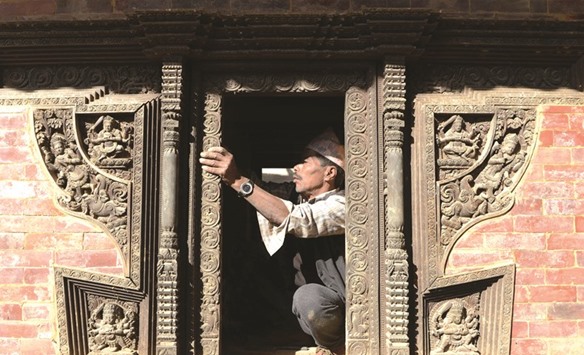Caretaker Deepak Shrestha padlocked shut the quake-ravaged remains of the Trailokya Mohan Narayan shrine in Nepal’s capital Kathmandu to keep out the contractors who are meant to be rebuilding it.
The 17th century monument’s three-tiered pagoda completely collapsed in a 7.8 magnitude earthquake that hit the Himalayan nation in April 2015.
Shrestha, whose family has looked after the shrine for generations, is now on a mission to protect it from a government system that grants contracts to rebuild the quake-damaged heritage sites to the lowest bidder.
“We had our doubts about the contractors but it was confirmed when they started digging the foundations haphazardly, disregarding the community’s involvement and our sacred
rituals,” Shrestha, 56, said.
“We don’t believe the cheapest contractors will rebuild our shrine sincerely. We demand that the government dismiss such a system.”
The shrine was among more than 700 heritage sites damaged in the disaster which killed nearly 9,000 people and destroyed half a million homes.
Nepal’s laws state that construction contracts valued at more than Rs500,000 ($4,670) must be granted through a tender process to the lowest bidder - and the same rules govern the restoration of ancient buildings.
The system has raised alarm over the quality and techniques being used to rebuild historical sites - with experts saying the Kathmandu valley’s status as a Unesco World Heritage site could be under threat.
“The lowest bidder is not necessarily the best,” Christian Manhart, head of Unesco in
Nepal, said.
“There are strong chances that it can be in the world heritage in danger (list),” he added.
When the Unesco World Heritage committee met in July last year, it narrowly avoided putting the Kathmandu Valley on its “List of World Heritage in Danger”, but warned it could be added in 2017 if progress is not made.
The government estimates that rebuilding the centuries-old temples and monuments damaged by the quake will cost over $300mn.
Several countries who have pledged support to help Nepal rebuild its cultural heritage have also expressed concerns about the tender process and the slow pace of work.
Nearly two years since the earthquake struck, only ten monuments have so far been rebuilt - some totally bypassing the government’s rules.
In November last year, the Boudhanath stupa reopened having been restored with donations from international groups.
The restoration was largely community-led and cost $2.1mn, including over 30kg (66 pounds) of gold.
Bhesh Narayan Dahal, chief of Nepal’s archaeology department, said he is aware of concerns regarding the construction contract system and is hopeful the government will respond.
“The demands of local communities are justified... but we are helpless, we cannot work beyond the limits of the government’s laws, acts and rules,”
Dahal said.
Communities are now demanding that the government process be scrapped and they be allowed to take lead in rebuilding.
However, dozens of contracts to rebuild cultural monuments have already been granted and more are in the process.
Experts also worry that contractors who lack experience of working on heritage projects won’t have the contacts to hire traditional wood carvers, stone sculptors and metal workers.
Birendra Shrestha, who is leading a campaign to rebuild Kathmandu’s Kasthamandap with community involvement, said locals will continue to battle against the tender process.
“Lowest bidders cannot maintain quality... Residents of Kathmandu can tolerate anything, but cannot tolerate an attack on our heritage.”

A worker renovates a heritage site at Durbar Square in Kathmandu.
